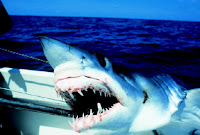
Alligator, Fish or Both? The alligator gar — an ancient fish that has existed for 100 million years — roams the rivers, streams and bayous of the southeastern United States. It gets its name from its alligator-like snout and its double row of dagger sharp teeth. Unlike most of its close relatives, the alligator gar can breathe air and survive above water for up to two hours. Its body is covered in an armor plating of diamond-shaped, enamel-coated ganoid scales, and it's been said that this shining armor can produce sparks when struck by an axe.
The Devil Fish: The alligator gar stands accused of vicious human attacks, most notably at Lake Pontchartrain in Louisiana. A New Orleans newspaper once published an article contending that the alligator gar is more dangerous to human life than the "man-eater shark." But little evidence exists to suggest that this fish is actually aggressive towards humans, raising the question of whether the alligator gar has been wrongly accused of attacks perpetrated by an animal with a real track record of violence — the American alligator.






















